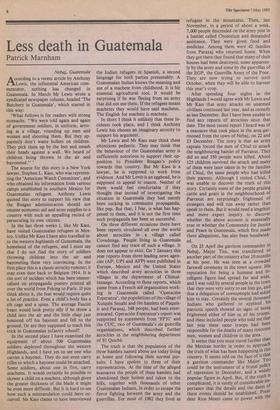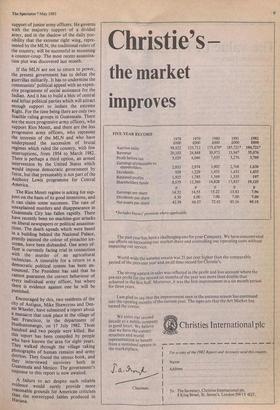Less death in Guatemala
Patrick Marnham
Nebaj, Guatemala
According to a recent article by Anthony Lewis, the influential American com- mentator, nothing has changed in Guatemala. In March Mr Lewis wrote a syndicated newspaper column, headed 'The Butchery in Guatemala', which started in this way:
`What follows is for readers with strong stomachs. "We were told again and again of government soldiers, in uniform, arriv- ing at a village, rounding up men and women and shooting them. But they ap- parently don't waste bullets on children. They pick them up by the feet and smash their heads against a wall. We heard of children being thrown in the air and bayoneted." ' The source for this story is a New York lawyer, Stephen L. Kass, who was represen- ting the 'American Watch Committee', and who obtained his information from various camps established in southern Mexico for Guatemalan refugees. Anthony Lewis quoted this story to support his view that the Reagan administration should not resume economic aid and arms supplies to a country with such an appalling record of persecuting its own citizens.
In the last three weeks I, like Mr Kass, have visited Guatemalan refugees in Mex- ico. Unlike Mr Kass I have also travelled in- to the western highlands of Guatemala, the homeland of the refugees, and I must say that I do not find the story of soldiers throwing children into the air and bayoneting them very convincing. In the first place this is a classic atrocity rumour; it may even date back to Belgium 1914. It is the sort of incident which has been immor- talised on propaganda posters printed all over the world from Peking to Paris. If you think about it, the feat would require quite a lot of practice. Even a child's body has a rib cage and a spine. The average Fascist beast would look pretty silly if he threw a child into the air and the little chap just bounced off his bayonet and fell to the ground. Or are they supposed to teach this trick in Guatemalan infantry school?
In the second place I have examined the equipment of about 500 Guatemalan soldiers deployed throughout the western Highlands, and I have yet to see one who carries a bayonet. They do not even carry rifles to which a bayonet could be attached. Some soldiers, about one in five, carry machetes. It would certainly be possible to skewer a child on a machete, although given the greater thickness of the blade it might be even more difficult. But it is hard to see how such a mistranslation could have oc- curred. Mr Kass claims to have interviewed the Indian refugees in Spanish, a second language for both parties presumably. A Guatemalan Indian knows the meaning and use of a machete from childhood. It is his essential agricultural tool. It would be surprising if he was fleeing from an army that did not use them. If the refugees meant machetes they would have said machetes. The English for machete is machete.
In short I think it unlikely that these in- cidents took place, and I think Anthony Lewis has chosen an imaginary atrocity to support his argument.
Mr Lewis and Mr Kass may think these objections pedantic. They may think that the behaviour of the Guatemalan army is sufficiently notorious to support their op- position to President Reagan's policy towards that country. But Mr Kass is a lawyer, he is supposed to work from evidence. And Mr Lewis is an egghead, he is supposed to appeal to reason. Neither of them would feel comfortable if they thought that instead of investigating the situation in Guatemala they had merely been sucking in communist propaganda, like pap. But that, I fear, is what has hap- pened to them, and it is not the first time such propaganda has been so successful.
On three different occasions there have been reports circulated all over the world about atrocities in a village called Covadonga. People living in Guatemala cannot find any trace of such a village. It does not appear to exist. On 7 January this year reports from three leading news agen- cies (AP, UPI and AFP) were published in Europe, Mexico and the United States which described army atrocities in three villages in the department of Chimal- tenango. According to these reports, which came from a French aid organisation work- ing in Guatemala called `Operacion Esperanza', the populations of the village of Xuiquin Senahi and the hamlets of Paquix- ic and Paraxaj, 348 people, had been exter- minated. Operacion Esperanza's report was supported by statements from `FP31' and the CUC, two of Guatemala's six guerrilla organisations, which described further atrocities in the neighbouring department of El Quiche.
The truth is that the population of the three hamlets named above are today living at home and following their normal pur- suits. I have spoken to three of their representatives. At the time of the alleged massacres the people of these hamlets had abandoned their homes and taken to the hills, together with thousands of other Guatemalan Indians, in order to escape the fierce fighting between the army and the guerrillas. For most of 1982 they lived as refugees in the mountains. Then, last November, in a period of about a week, 7,000 people descended on the army post in a hamlet called Choatelum and demanded assistance. They were given food and medicine. Among them were 42 families from Paraxaj who returned home. When they got there they found that many of their houses had been destroyed, some apparent- ly by the army and some by the guerrillas of the EGP, the Guerrilla Army of the Poor. They are now trying to survive until October, when they will be able to harvest this year's crop.
After spending four nights in the Highlands I would agree with Mr Lewis and Mr Kass that army attacks on unarmed civilians continued last year, and as recently as last December. But I have been unable to find any reports of atrocities since that date. The most recent report I heard was of a massacre that took place in the area gar- risoned from the town of Nebaj, on 22 and 23 December. The story is that an army captain forced the men of Chiul to attack the neighbouring hamlet of Parraxut. They did so and 350 people were killed. About 125 children survived the attack and many of them were later taken in by the families of Chiul, the same people who had killed their parents. Although I visited Chiul, I was unable to discover the truth of this story. Certainly some of the people grazing cattle and goats in the neighbourhood of Parraxut are surprisingly frightened of strangers and will run away rather than speak to them. But it would need a lengthier and more expert inquiry to discover whether the above account is essentially true or whether the Community for Justice and Peace in Guatemala, which first made these allegations, has also been hoodwink- ed.
On 23 April the garrison commander in Nebaj, Major Tito, was transferred to another part of the country after 10 months at his post. He was seen at a crowded farewell ceremony in the town square. HIS reputation for being a humane and in- telligent figure had spread far and wide, and I was told by several people in the town that they were very sorry to see him go, and that a delegation of townspeople had asked him to stay. Certainly the several thousand Indians who gathered to applaud his patriotic speech showed no signs of being frightened either of him or of his troops, and these included people who told me that last year these same troops had been responsible for the deaths of many innocent men, women and children in the area.
It seems that you must travel further than the Mexican border in order to approach the truth of what has been happening in this country. It seems odd on the face of it that a garrison commander like Major Tito could be the instrument of a brutal policy of repression in December, and a widely popular figure in April. But, if the truth is complicated, it is surely of considerable im- portance that the details and the dates of these events should be established. presi dent Rios Montt came to power with the support of junior army officers. He governs with the majority support of a divided army, and in the shadow of the daily pos- sibility that the extreme right wing, repre- sented by the MLN, the traditional rulers of the country, will be successful in mounting a counter-coup. The most recent assassina- tion plot was discovered last month.
If the MLN are not to return to power, the present government has to defeat the guerrillas militarily. It has to undermine the communists' political appeal with an expen- sive programme of social assistance for the Indian. And it has to build a bloc of central and leftist political parties which will attract enough support to isolate the extreme Right. For the time being there are only two feasible ruling groups in Guatemala. There are the more progressive army officers, who support Rios Montt, and there are the less progressive army officers, who represent the interests of the MLN and who have underpinned the succession of brutal regimes which ruled the country, with few interruptions, from 1954 to March 1982. There is perhaps a third option, an armed intervention by the United States which would impose democratic government by force, but that presumably is not part of the Anthony Lewis programme for Central America.
The Rios Montt regime is asking for sup- port on the basis of its good intentions, and it can claim some successes. The rate of unexplained murders and disappearance in Guatemala City has fallen rapidly. There have recently been no machine-gun attacks on liberal newspapers or political assassina- tions. The death squads which were based in a building behind the National Palace, prettily painted the colour of pistachio ice- cream, have been disbanded. One army of- ficer is currently facing trial in connection with the murder of an agricultural technician. A timetable for a return to a democratic political system has been an- nounced. The President has said that he cannot guarantee the correct behaviour of every individual army officer, but where there is evidence against one he will be punished.
Encouraged by this, two residents of the My of Antigua, Mike Shawcross and Den- nis Wheeler, have submitted a report about a massacre that took place in the village of San Francisco, in the department of Huehuetenango, on 17 July 1982. Three hundred and two people were killed. But this report has been compiled by people who have known the area for eight years. They walked through the village taking photographs of human remains and army detritus. They found the census book, and they interviewed survivors both in Guatemala and Mexico. The government's response to this report is now awaited.
A. failure to act despite such reliable evidence would surely provide more reasonable grounds for American criticism than the stereotyped fables produced in Havana.











































 Previous page
Previous page